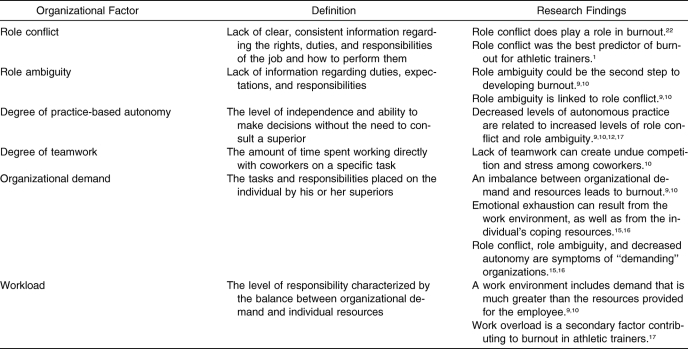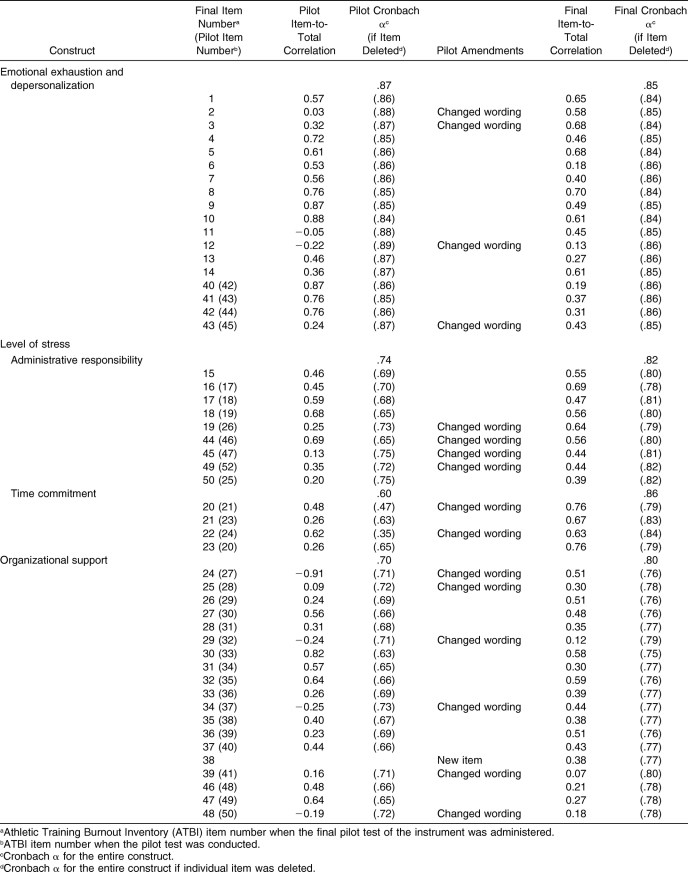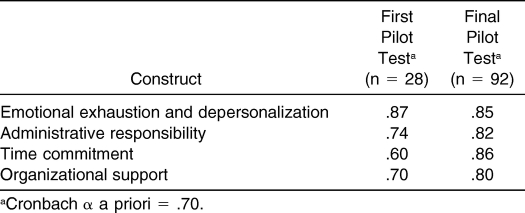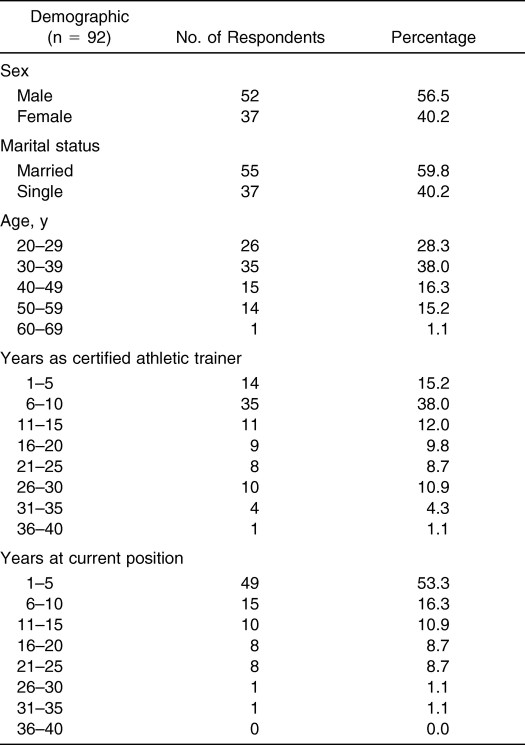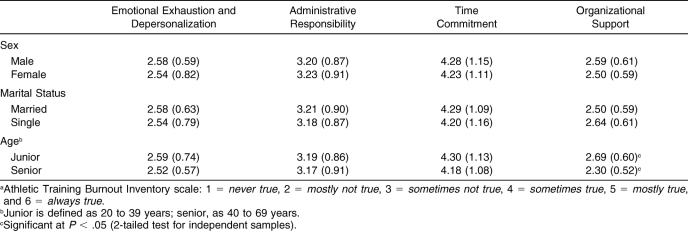Abstract
Context: The existing investigations of professional burnout among certified athletic trainers (ATs) were conducted before 2000. Since 2000, several educational and legal changes have redefined the job duties and responsibilities of the AT working in collegiate athletics.
Objective: To develop an instrument to determine factors that contribute to burnout in ATs employed within the collegiate athletics setting.
Design: Descriptive study.
Setting: National Collegiate Athletic Association (NCAA) Division I-A universities.
Patients or Other Participants: Instrument design experts and ATs employed in various NCAA Division I-A athletic programs.
Main Outcome Measure(s): The Athletic Training Burnout Inventory (ATBI) included the Maslach Burnout Inventory (18 items) plus 45 new items to address established factors that lead to burnout and to address workload issues specific to athletic training. We initially developed 3 constructs (emotional exhaustion and depersonalization, level of stress, and level of organizational support) and included them in the 2 field tests and first pilot test of the ATBI. For the second pilot test, the instrument comprised 4 constructs: emotional exhaustion and depersonalization, administrative responsibility, time commitment, and organizational support. The 2 field tests were conducted to establish face and content validity of the ATBI. Reliability analyses were conducted twice on the 2 separate pilot tests using a Cronbach α set a priori at .70 and an item-to-total correlation.
Results: The second pilot test of the ATBI with the 4 constructs was determined reliable (emotional exhaustion and depersonalization, α = .85; administrative responsibility, α = .82; time commitment, α = .86; and organizational support, α = .80); however, some items within 2 constructs appeared suspect with low item-to-total correlations (<0.25).
Conclusions: The second administration of the ATBI produced an acceptable response rate. All 4 constructs were reliable; however, the suspect items within the constructs need further investigation. Researchers need to evaluate the conceptual worth of these items to the entire instrument.
Keywords: depersonalization, time commitment, organizational support, Maslach Burnout Inventory
Key Points
The Athletics Training Burnout Inventory provides a reliable way to describe factors that lead to burnout in athletic trainers employed in Division I-A collegiate athletics.
The instrument needs small changes and more testing to further establish its reliability and validity for assessing burnout in athletic trainers.
The sex and the marital status of athletic trainers were not related to burnout.
Only age appeared to affect the way athletic trainers perceive organizational support.
The phenomenon known as burnout was first described by Freudenberger,1 whose office staff was experiencing a noticeable decline in quality of patient care, a gradual emotional depletion, and a loss of motivation and commitment. Since then, many authors2–16 have studied burnout in members of the helping professions, ranging from police officers to medical personnel.
The definition of burnout varies considerably because each researcher2–16 has created a unique definition. Maslach and Jackson2 first studied burnout in police officers, teachers, and medical personnel and ultimately operationalized burnout into 3 parts: emotional exhaustion, depersonalization, and decreased personal accomplishment. Today, this 3-part definition provides the skeleton for the Maslach Burnout Inventory (MBI), which is the most universally used instrument in the study of burnout.2–7
Cherniss8–10 hypothesized that burnout is preceded by an imbalance between the demands of the organization and the resources that the organization provides. According to Cherniss,8–10 burnout is a transactional process in which the organizational demands outweigh the organizational support, ultimately making the employee vulnerable to typical work stressors in the form of anxiety, tension, fatigue, and exhaustion. This transactional process is slightly different from the process of Maslach3,4,6 and Maslach et al2,5,7 in which emotional exhaustion, depersonalization, and decreased accomplishment occur simultaneously and independent of organizational demand and support. The MBI does not include items to assess the concept of organizational imbalance that Cherniss8–10 proposed.
In their definition of burnout, Pines and Aronson11 included physical exhaustion in addition to mental exhaustion caused by stressful situations. The inclusion of physical and mental exhaustion generated a more holistic view of burnout, which is not represented in the MBI. Leiter and Maslach13 and Leiter14–16 believed that environmental aspects affect the factors that contribute to burnout as much as the originally identified personal factors of emotional exhaustion, depersonalization, and decreased personal accomplishment affect them.2–7 The model of Leiter and Maslach13 and Leiter14–16 stated that occupational stressors, such as work overload and coworker conflicts, may have a direct effect on emotional exhaustion and burnout. This model aligned more with the ideas of organizational demand and physical exhaustion of Cherniss,8–10 Pines and Aronson,11 and Pines.12
After 3 decades of research,2–16 the concepts of emotional exhaustion, depersonalization, and decreased personal accomplishment as operational definitions of burnout appear to be well established. However, concepts, such as role conflict,17–20 role ambiguity,8,9 degree of practice-based autonomy,8,9,12,17 degree of teamwork,8–10 organizational demand,8–10,14,15 and workload3,8–10,14,15,17,21 have been identified as potential environmental factors that can interact with the original factors established by Maslach3,4,6 and Maslach and associates2,5,7 Table 1 provides a review of the organizational factors that have been identified as factors that can contribute to burnout.
Table 1. Organizational Factors Contributing to Burnout.
Burnout in Athletic Training
Used since 1982, the MBI has become the standard instrument for assessing the level of burnout among members of the helping professions.1,2,5,21,23 However, research19 suggests that each helping profession needs its own version of the MBI to gauge the level of burnout among its members. Capel17,21 studied burnout in athletic trainers (ATs) on the West Coast in the mid-1980s, marking the first study of this subject in athletic training. Using the MBI in combination with 2 newly developed constructs, Capel17,21 identified 5 factors that contributed to burnout within the profession of athletic training: role conflict, high time commitment, limited opportunities for career advancement, low salary, and poor working conditions. Campbell et al24 followed Capel's study17,21 with an investigation of ATs attending the National Athletic Trainers' Association (NATA) Symposium in 1985. Using a questionnaire (response rate = 15%) designed to assess stress levels and the occurrence of specific medical conditions resulting from fatigue and substance abuse, Campbell et al24 noted that 40.7% of the respondents reported fatigue, 30.3% reported irritability, and 24.9% reported weight management problems. In a more recent study of burnout in athletic training, Hendrix et al23 investigated ATs employed at National Collegiate Athletic Association (NCAA) Division I universities with football programs. Their questionnaire focused on 2 areas. One area included questions about workload, locus of control, social support, and perceived stress levels, and the second area included the MBI. The results (response rate = 52%) described ATs as experiencing higher levels of emotional exhaustion and depersonalization than members of other helping professions, yet the level of personal accomplishment was higher among ATs than members of other helping professions.
The established studies of burnout in all helping professions have provided a solid foundation upon which to build and incorporate environmental stressors and the MBI into a new instrument specifically designed to assess burnout in athletic training and its contributing factors. Since the report of Hendrix et al,23 several educational and professional changes have occurred through the direction of the NATA, the Commission on Accreditation of Allied Health Education Programs (CAAHEP), and the Commission on Accreditation of Athletic Training Education.22 Compared with ATs in years past, ATs serving as clinical instructors today have experienced increased supervisory responsibilities, as well as increased pressure to provide more comprehensive care to the student-athlete in a media-driven environment.22 In addition, several high-profile deaths of athletes have created a more litigious environment for ATs.25,26 Considered collectively, these issues have created a potentially more stressful environment in which burnout among ATs employed within collegiate athletics may have increased.1,23 The purpose of our study was to develop an instrument to determine the factors that contribute to burnout in ATs employed within the collegiate athletics setting.
METHODS
Athletic Training Burnout Inventory
We revised the MBI to make the scale and items assessing burnout more specific to ATs in the collegiate setting, and we added new constructs to reflect the observations of many authors.8–17,21,23,24 We named our instrument the Athletic Training Burnout Inventory (ATBI).
Instrumentation
We obtained and modified the MBI with the permission of the Consulting Psychologists Press (Mountain View, CA). The institutional review board of the university granted approval before we conducted field and pilot tests of the revised instrument. For the 2 field tests and the administration of the first pilot test, we included 3 constructs: emotional exhaustion and depersonalization, level of stress, and level of organizational support. For the first construct, we included 18 items within the MBI that were designed to describe the level of emotional exhaustion and depersonalization. A second construct describing the level of stress was included because various authors17,21,23,24 indicated that workload, number of athletes, total contact hours, and coworker relationships could affect the factors that contribute to burnout in ATs. Leiter and Maslach13 and Leiter14–16 observed that decreased levels of personal achievement directly resulted from the organizational imbalance, so we eliminated from the MBI the 4 items designed to describe the level of personal achievement. In their place, items addressing the level of organizational support and demand were added as the third construct.
First Field Test
To establish face validity, 6 experts were identified and solicited for feedback regarding the validity of the ATBI. Three experts were senior ATs, each with more than 10 years of experience in the field; 3 were experts on instrumentation, each having designed and validated questionnaires and published research on questionnaire findings. We asked the 6 experts to make suggestions regarding the clarity in measuring emotional exhaustion and depersonalization, level of stress, and organizational support and in measuring the demographics within each construct. The experts also were asked to comment on the overall presentation of the instrument.
The feedback from the 6 experts resulted in several amendments to the ATBI. Based upon their comments, we modified the original scale of the MBI from a scale of 0 to 6 points to a scale of 1 to 6 points where 1 indicated never true, 2 indicated mostly not true, 3 indicated sometimes not true, 4 indicated sometimes true, 5 indicated mostly true, and 6 indicated always true. The decision for changing the scale of the MBI was complicated and involved the acceptance of an imposed limitation. If the original scale was amended, it would have prohibited the comparison of ATBI scores with MBI scores. This limitation was reconciled because we decided that comparing the ATBI scores with MBI scores reported in other studies was not of primary importance for instrument development.
Consequently, we amended the original MBI scale to use a consistent scale throughout all constructs. We believed that 1 consistent scale would limit the amount of measurement error that may occur when using different scales for different items. In addition, we consciously decided that, at this point in instrument development, insufficient data existed to create cut scores like the ones used with the MBI to assess burnout. The ability of the ATBI to assess burnout is certainly a future goal, but it is not a goal that is achievable with 1 administration of the instrument.
In addition to the change in the scale, the 3 constructs (emotional exhaustion and depersonalization, level of stress, and level of organizational support) were collapsed into 1 complete instrument. Items that were designed specifically for ATs employed at institutions with CAAHEP-accredited programs were repositioned and shaded to simplify the instructions. Lastly, items regarding ethnicity were eliminated from the demographics section of each construct. Given the close-knit community of ATs, some experts expressed concern that items designed to identify racial or ethnic backgrounds could expose identities.
Second Field Test
Content validity was established through the feedback from 10 ATs employed at a large midwestern NCAA Division I university. The ATs were asked to provide comments regarding the format and comprehension of each item. Following review of the comments, items within each construct were amended. The amendments mostly represented changing words or revising sentence structure to increase item comprehension. Specific items within each demographics section also were amended at the suggestions of the ATs. Because the ATs were aware that the ATBI was going to be administered within select NCAA conferences, many ATs expressed concern that, when taken in consideration with the sex of the individual, open-ended questions regarding age and years of experience might expose identities. For this reason, questions about years of experience and age were presented as a range (eg, 20–29). We wanted to obtain a response rate that would enable us to make sound statistical decisions regarding reliability of the main constructs. To do so would require us to use our networking to encourage participation, but it also would require us to change items within each demographics section to protect the identities of ATs with whom we were networking.
Administration and Reliability of the First Pilot Test
The ATBIs were mailed to 50 ATs at 4 NCAA Division I universities representing the Southeastern Conference, Western Athletic Conference, and Big East Conference. A total of 28 of 50 ATs (55%) completed the instrument by the deadline. To establish reliability, we used a Cronbach α coefficient set a priori at .70 to analyze each construct. Each item within the constructs also was analyzed with an item-to-total correlation. Correlations less than 0.25 were considered suspect. All suspect items were eliminated or revised before the final pilot test (second administration) of the ATBI.
The first construct, emotional exhaustion and depersonalization, produced a Cronbach α of .87. Four items were considered suspect because of a low item-to-total correlation. These items were not eliminated, but they were revised to improve comprehension. Table 2 presents the internal consistency data for each item and construct.
Table 2. Reliability of Athletic Training Burnout Inventory Constructs After Administration of the First Reliability Pilot Test.
The second construct, level of stress, produced a low Cronbach α of .57 and 7 suspect items. To address the low Cronbach α, the construct was evaluated qualitatively, and 2 different themes emerged. One theme appeared to represent administrative responsibilities (eg, paperwork, meetings), and the other theme represented time commitment (eg, weekend hours, time away from family). Thus, level of stress was split into 2 separate constructs (administrative responsibility and time commitment), which resulted in Cronbach αs of .74 and .60, respectively. Following the split, 2 items were identified in administrative responsibility as suspect, but only 1 item was revised for the final pilot test. We considered the other item acceptable and rationalized that perhaps the item would test better in a larger population. Despite having appropriate item-to-total correlations, other items were revised for the final pilot test within the constructs of administrative responsibility and time commitment to increase respondent comprehension.
The third construct, level of organizational support, produced a Cronbach α of .70. Eight items were identified as suspect. These items were not discarded because they were determined to be meaningful; however, 6 were revised for the final pilot test to increase comprehension and eliminate potential confusion. Two items remained unchanged because we believed that they would test better in a larger population.
Based on the results of the reliability analysis, 4 constructs were included in the final pilot test of the instrument: emotional exhaustion and depersonalization, administrative responsibility, time commitment, and organizational support. Demographic items were included to assess sex, age range, marital status, range of years at current position, and range of years in the profession. The construct of emotional exhaustion and depersonalization was based upon the MBI and included 18 items that described the type of influence ATs have on their coaches and athletes, as well as the level of emotional “hardening” and frustration the respondents reported as a result of their jobs. The construct of administrative responsibility included 9 items that identified the amount of work-related responsibility that the respondents reported (eg, pressure to get things done, amount of paperwork). The construct of time commitment consisted of 4 items that described how respondents perceived time away from their families. The construct of organizational support comprised 19 items that described the relationships of the respondents with their organizations.
Administration of the Final Pilot Test
The ATBIs were mailed to every AT (n = 109) employed within the 11 institutions in 1 Division I-A conference. The institutions were consciously selected to use our networking to encourage an acceptable response rate. We prioritized response rate above generalizability at this point in instrument development.
Statistical Analysis
To establish reliability of the final pilot test, we used a Cronbach α coefficient set a priori at .70 to analyze each construct. Each item within the constructs also was analyzed with an item-to-total correlation. Correlations less than 0.25 were considered suspect.
With this final pilot test of the ATBI, descriptive statistics (ie, mean, SD) were reported for each construct, and 2-tailed independent-samples t tests (P < .05) were conducted to explain the relation of sex, age, and marital status with each construct. The statistical analysis was performed using the SPSS (version 12.0; SPSS Inc, Chicago, IL).
RESULTS
Reliability of the Final Pilot Test
Ninety-two ATs returned completed instruments, producing an 84.4% response rate. We defined a completed instrument as an instrument that had no more than 2 missing items. Some respondents did not complete the demographic questions, perhaps to protect their identities. The Cronbach α for all constructs was equal to or more than .80 (Table 3), and deleting any 1 item would not have increased the Cronbach α of any 1 construct by more than .01.
Table 3. Reliability of Athletic Training Burnout Inventory Constructs.
Descriptive Statistics
Table 4 outlines the descriptive statistics for each demographic reported by the respondents of the final pilot test; therefore, this is a description of the population of survey respondents and may not be generalizable to all ATs. Most respondents (66.3%) were from 20 to 39 years. The remaining respondents (32.6%) were from 40 to 69 years. The average number of years that the respondents reported being employed as an AT was 13.73 ± 9.33 years. The average number of years respondents reported at their current positions was 8.39 ± 7.63 years. Most respondents (53.3%) reported serving in their current positions from 1 to 5 years.
Table 4. Athletic Training Burnout Inventory Demographic Descriptive Statistics for the Division I Major Conference Respondents.
After reviewing the data, we dichotomized age because the data for the 2 groups less than 40 years were similar and for the 2 groups 40 or more years were similar; however, the data for the participants who were less than 40 years were different from the data for the participants who were 40 or more years. The ATs from 20 to 39 years were considered junior and from 40 to 69 were considered senior.
Based on the ATBI scale, the mean of the first construct, emotional exhaustion and depersonalization, was 2.56 ± 0.69. Table 5 lists the average construct minimum and maximum along with the mean and SD of each construct. An independent-samples t test of the construct revealed no statistical differences for sex (t87 = 0.24, P = .81), marital status (t89 = 0.29, P = .77), or age (t89 = 0.49, P = .63; Table 6).
Table 5. Athletic Training Burnout Inventory Construct Descriptive Statisticsa.
Table 6. Mean Response (SD) in Relation to Sex, Marital Status, and Agea.
The mean of the second construct, administrative responsibility, was 3.19 ± 0.87. An independent-samples t test of the construct revealed no statistical differences for sex (t67 = −0.16, P = .88), marital status (t69 = 0.12, P = .90), or age (t69 = 0.07, P = .95). The third construct, time commitment, produced a mean of 4.25 ± 0.59 with no statistical differences for sex (t85 = −0.19, P = .85), marital status (t86 = 0.36, P = .72), or age (t86 = 0.47, P = .64). The mean of the fourth construct, organizational support, was 2.54 ± 0.59. An independent-samples t test of the construct revealed no statistical differences for sex (t65 = 0.87, P = .55) or marital status (t67 = −0.88, P = .38). Age, however, was statistically different (t67 = 2.75, P = .01).
DISCUSSION
We compared the results of our study with the results of other studies for self-reported emotional exhaustion and depersonalization, and we found that our study produced results similar to results reported in other studies of athletic training burnout.17,21,23 When evaluating each ATBI construct relative to its relationship to sex, marital status, and age, we found that the ATBI again appeared to produce similar results to results reported by other researchers investigating burnout in athletic training17,21,23 and other helping professions.2–7 However, because we changed the scale on the ATBI, we caution the reader against making sweeping comparisons between previous studies and our study. Maslach3,4,6 and Maslach et al2,5,7 are the only referenced investigators who reported that age affects the rate at which one reaches professional burnout. She and her colleagues attributed this result to a lack of experience and time on the job. No author17,21,23 reported this trend in athletic training. In our study, the only construct in which age produced a significant difference was in organizational support (P = .01), where younger ATs reported lower levels of perceived organizational support. The sex and the marital status of the ATs were not related to burnout in our study, which was a finding similar to the results reported by Capel,17,21 Hendrix et al,23 Maslach3,4,6 and Maslach et al.2,5,7
The final pilot test of the ATBI produced a response rate (84.4%) that exceeded the typical minimal standard (80%).27 This finding was important because it increased our confidence in our statistical analyses assessing reliability. All 4 constructs had a Cronbach α more than the a priori value (>.70); however, some items with low item-to-total correlations (<0.25) still seemed suspect. Items 6, 12, and 40 within emotional exhaustion and depersonalization and items 29, 39, 46, and 48 within organizational support had low item-to-total correlations. This result was unexpected because the 3 suspect items within emotional exhaustion and depersonalization were items taken from the MBI and amended to reflect AT duties. Only 1 word was changed in each of those items (eg, “patients” was changed to “coaches or athletic training students”). The worth of the 4 suspect items within organizational support needs to be reevaluated, especially considering 3 of the 4 items were suspect items on the first administration of the ATBI. Within the constructs of administrative responsibility and time commitment, no suspect items were reported.
The ATBI requires some small amendments. Before the first re-administration of the ATBI to a sample of collegiate ATs, the demographics section should be amended. The ranges of age, years of experience, and years at current position should be removed and returned to an open-ended response. This change will enable researchers to investigate the issue of age and professional experience relative to burnout and its contributing factors in more detail. This phenomenon deserves more attention than the final pilot test enabled.
To determine if burnout is occurring, investigators need to assess if the trend observed within these specific Division I institutions (66.3% of the ATs reporting an age less than 39 years) is consistent across other collegiate settings. Division I should be compared with Divisions II and III to determine if differences exist in the factors that contribute to burnout and the level of burnout across the various NCAA levels. Moreover, investigators should attempt to amend the ATBI to determine the factors that contribute to burnout in settings outside of collegiate athletics (eg, high school, outpatient clinical, professional, and industrial).
The last issue for future investigators involves creating cut-scores for assessing burnout and determining the factors that contribute to burnout. Cut scores can be created once multiple administrations of the ATBI have been conducted and a large enough data set exists to create such scores.
CONCLUSIONS
We developed an instrument with acceptable reliability to describe the factors that contribute to burnout in ATs employed in Division I-A athletics. The ATBI produced results similar to those of other instruments, not only regarding the factors that contribute to burnout in athletic training but also regarding the relationship of sex, marital status, and age to the factors that contribute to burnout. However, a few items within the constructs of emotional exhaustion and depersonalization and organizational support need more testing to further establish the reliability and validity for using the ATBI to assess burnout.
Acknowledgments
This manuscript was presented as an oral presentation at the Free Communications Section of the Great Lakes Athletic Trainers' Association Convention in Madison, WI (March 2006), and as a thematic poster at the National Athletic Trainers' Association Convention in Atlanta, GA (June 2006).
REFERENCES
- Freudenberger HJ. Staff burn-out. J Soc Issues. 1974;30(1):159–166. [Google Scholar]
- Maslach C, Jackson SE. The measurement of experienced burnout. J Occup Behav. 1981;2(2):99–113. [Google Scholar]
- Maslach C. Burnout: The Cost of Caring. Edgewood Cliffs, NJ: Prentice-Hall; 1982.
- Maslach C. Burnout: a multidimensional perspective. In: Schaufeli WB, Maslach C, Marek T, eds. Professional Burnout: Recent Developments in Theory and Research. Washington, DC: Taylor & Francis; 1993:19–32.
- Maslach C, Jackson SE, Leiter M. The Maslach Burnout Inventory. In: Zalaquett CP, Wood RJ, eds. Evaluating Stress: A Book of Resources. 3rd ed. Lanham, MD: Scarecrow Press; 1997:191–218.
- Maslach C. A multidimensional theory of burnout. In: Cooper C, ed. Theories of Organizational Stress. New York, NY: Oxford University Press; 1998:68–85.
- Maslach C, Leiter M. Burnout and health. In: Baum AS, Revenson TA, Singer JE, eds. Handbook of Health Psychology. Mahwah, NJ: Lawrence Erlbaum Associates; 2001:415–426.
- Cherniss C. Professional Burnout in Human Service Organizations. New York, NY: Praeger; 1980:158–179.
- Cherniss C. Staff Burnout: Job Stress in the Human Services. Beverly Hills, CA: Sage; 1980.
- Cherniss C. Burnout: two ways of defining it and their implications. Paper presented at: 90th Annual Convention of the American Psychological Association; August 23–27, 1982; Washington, DC.
- Pines A, Aronson E. Career Burnout: Causes and Cures. 2nd ed. New York, NY: Free Press; 1988:80–96.
- Pines A. Burnout: an existential perspective. In: Schaufeli WB, Maslach C, Marek T, eds. Professional Burnout: Recent Developments in Theory and Research. Washington, DC: Taylor & Francis; 1993:33–52.
- Leiter MP, Maslach C. The impact of interpersonal environment on burnout and organizational commitment. J Organ Behav. 1988;9(4):297–308. [Google Scholar]
- Leiter MP. Coping patterns as predictors of burnout: the function of control and escapist coping patterns. J Organ Behav. 1991;12(2):123–144. [Google Scholar]
- Leiter MP. The dream denied: professional burnout and the constraints of human service organizations. Can Psychol. 1991;32(4):547–555. [Google Scholar]
- Leiter MP. Burnout as a developmental process: consideration of models. In: Schaufeli WB, Maslach C, Marek T, eds. Professional Burnout: Recent Developments in Theory and Research. Washington, DC: Taylor & Francis; 1993:237–250.
- Capel S. Psychological and Organizational Factors Related to Burnout in Athletic Training [dissertation] Eugene, OR: The University of Oregon; 1985.
- Cooper C. Theories of Organizational Stress. ed. New York, NY: Oxford University Press; 1998:68–85.
- Cooper CL, Dewe PJ, O'Driscoll MP. Organizational Stress: A Review and Critique of Theory, Research, and Application. eds. Thousand Oaks, CA: Sage; 2001:37–43.
- Hallsten L. Burning out: a framework. In: Schaufeli WB, Maslach C, Marek T, eds. Professional Burnout: Recent Developments in Theory and Research. Washington, DC: Taylor & Francis; 1993:95–114.
- Capel S. Attrition of athletic trainers. Athl Train J Natl Athl Train Assoc. 1990;25(1):34–39. [Google Scholar]
- Joint Review Committee on Educational Programs in Athletic Training. 2005 standards for the accreditation of entry-level athletic training education programs. Commission on Accreditation of Athletic Training Education Self-Study Document. http://www.jrc-at.org/html/caate_standards.html. Accessed December 16, 2005.
- Hendrix AE, Acevedo EO, Hebert E. An examination of stress and burnout in certified athletic trainers at Division I-A universities. J Athl Train. 2000;35:139–144. [PMC free article] [PubMed] [Google Scholar]
- Campbell D, Miller M, Robinson W. The prevalence of burnout among athletic trainers. Athl Train J Natl Athl Train Assoc. 1985;20(2):110–113. [Google Scholar]
- Bauer N, Brophy J, Gustafson K, Horton K. Heat stroke: as related to the death of Korey Stringer. Univ Md Health Prof J. 2002;2(1):1–4. [Google Scholar]
- Mileur R. Steve Bechler dies at 23: plenty of blame to go around. www.baseballlibrary.com/baseballlibrary/submit/Mileur_Ray1.stm. Accessed August 21, 2005.
- Dillman DA. Mail and Internet Surveys: The Tailored Design Method. Hoboken, NJ: John Wiley & Sons; 2000:245–262.



